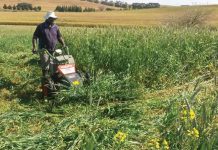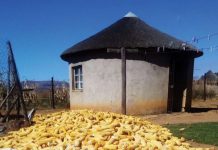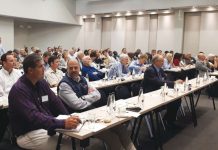June 2017
HANLIE KROESE, Santam
The silo has become an integral component of a grain storage management system for the modern producer and this necessitates the need for comprehensive insurance of the asset for any eventuality, either for weather-related events or other unexpected accidents.
According to Santam, failure of silos and bins happens more often than that of almost any other industrial structure and equipment, and silo failure, therefore, can be very costly to producers. The major causes of silo failure are design errors, construction errors and just basic operation errors, which will not be covered under the standard insurance contract.
As with any structure a silo must be properly maintained if it is to have a long, useful and safe life.
The maintenance of a silo is the responsibility of the producer and must not be neglected. The maintenance work includes the repair of the walls and/or inner liner used to promote flow. Periodic inspection of roof vents, level probes, feeders, dischargers and gates are also a requirement.
It is imperative that producers are covered against losses, which can be very high if large silos, bins and equipment are damaged. Insurance is critical and comprehensive cover that extends beyond weather-related events is crucial as unexpected accidents can happen.
All silo facilities are equipped to receive grain; and store and discharge it effectively. Drying and cleaning facilities are all part of the operations of grain storage. Grain dryer fires are one of the most significant risks a grain handling operation can face. The devastating results of fire can include death, serious injury, financial loss, property damage, business interruption and production downtime.
Dust explosions are a frequent hazard in grain elevators or oxygenlimiting silos. The force generated by such an explosion is sufficient to damage heavy structural members and propel heavy objects great distances.
The SANS Hazardous Area Classification and SANS 10108 certification are integral parts of regulating and managing hazardous areas and their electrical installations. They are especially important in safeguarding employees and equipment through the prevention of electrical fires and explosions. Special attention should be given to this regulation.
Santam statistics show that cutting, welding and other hot work operations conducted on an unsupervised basis have been responsible for many large fire losses due to the heat source igniting combustible materials in agriculture. It is advised to ensure proper control of cutting, welding and other hot work; farm management must establish a comprehensive Cutting – Welding-Grinding – Hot Work Permit programme.
This programme must be applicable to both in-house maintenance/ technical staff and external contractors. By applying a formal hot work programme, the potential of a fire loss to property as a result of hot work will be significantly reduced.
Other factors that must be noted in the risk management of silos are the importance of effective management of grain storage as grain can rapidly deteriorate, as well as the risk of severe damage from lightning strikes as silos are generally the tallest structures on the farm. While lightning rod protection systems can prevent damage to the structure, damage and fire can still result if lightning strikes hit the facility’s electrical system.
Loading or unloading belts, pulleys, shafts, and other mechanical apparatus in silos are also subject to mechanical failure and overheating. New motors used in silos and feed rooms have safety devices, but many older electrical motors have been modified; and supporting wiring and circuitry may be substandard. Older or misapplied units such as these are prone to arcing and overheating.
In addition, silo bags and bunkers should be insured for the contents and the bag/bunker. This is becoming an increasingly important form of insurance as more producers are making use of silo bags and bunkers on their farms. Silo bags are more cost effective to set up, but often the risk is greater as there are stipulations in terms of setting up, storage, clearing of the area around the bag and creating drainage for water to avoid flooding. Producers must spread their risk by not setting up all the silo bags in the same area, provided that this is practical given the layout of the farm.
Ultimately it is vital that the producer undertakes a proper needs analysis, in close co-operation with a broker to ensure all the risk factors are taken into consideration.
Santam believes choosing the right insurance partner with effective risk management is key to protecting your agricultural assets. We remain committed to assist the entire farming community in managing the risks endangering the sustainability of the agricultural sector. As the oldest insurer in the sector we have over 86 years of extensive experience in dealing with the highs and lows of agriculture. We want producers to know that we understand their requirements, that we value their contribution to the economy and sustainable food production and above all that we share their passion for farming.
Santam’s agri insurance products were developed around the specific needs of the producer and our cover is specific to the unique risks and requirements of the agricultural sector. Their specialist solutions ranging from pivot irrigation systems to livestock have been designed to suit the individual producers’ needs.
Details of the Santam cover
The fire section of the policy will cover damage to the whole or part of the property described in the schedule, owned by the insured or for which they are responsible, including alterations by the insured as tenants to the buildings and structures, by
- fire
- lightning or thunderbolt
- explosion
- such additional perils as are stated in the schedule to be included
- power surge.
The special perils extension will include damage caused by storm, wind, water, hail or snow. It also covers damage caused by aircraft and other aerial devices or articles dropped therefrom, impact by animals, trees, aerials, satellite dishes or vehicles excluding damage to such animals, trees, aerials, satellite dishes or vehicles or property in or on such vehicles.
This extension does not, however, cover:
- Wear and tear or gradual deterioration
- Damage caused or aggravated by:
- Leakage or discharge from any sprinkler or drencher system in the buildings insured hereby or
- In buildings containing property insured hereby
- Subsidence or landslip
- The insured’s failure to take all reasonable precautions for the maintenance and safety of the property insured and for the minimisation of any damage.
Contact your broker for more details about comprehensive agricultural insurance solutions.
Publication: June 2017
Section: Focus on

















